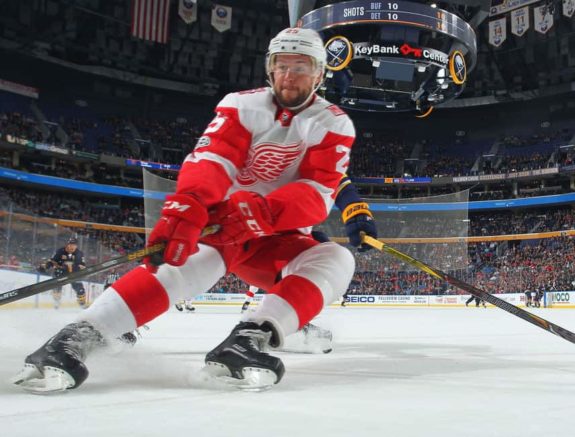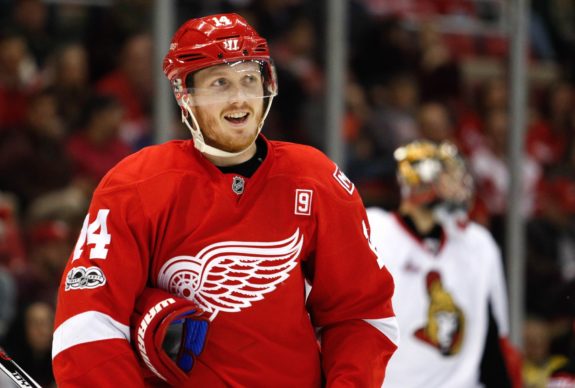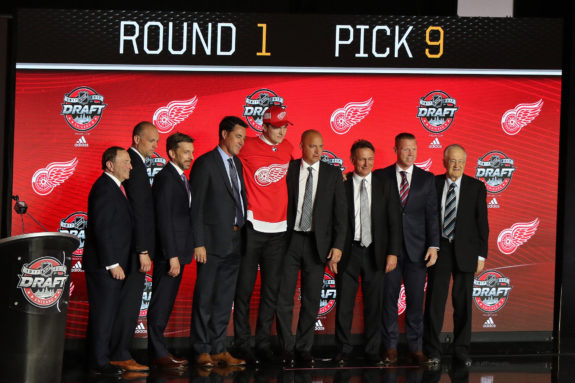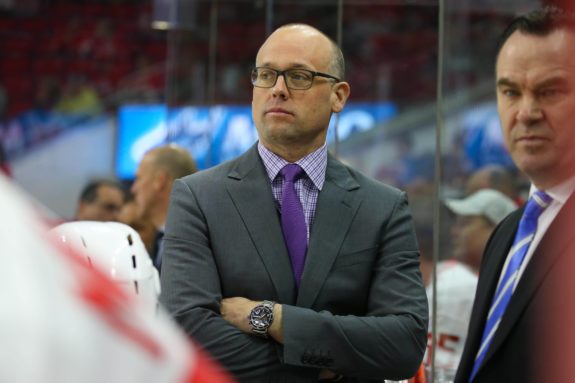Make no mistake about it, 2017 was not kind to the Detroit Red Wings.
Out of 84 regular season games from New Year’s Day to New Year’s Eve, the team won just 32 of them. They finished fifth-worst in that regard, posting just three more wins than the Colorado Avalanche, who finished last out of the 30 teams that participated in the 2016-17 and 2017-18 seasons.
For perspective, the upstart Vegas Golden Knights won 26 games last year and they didn’t begin regular season play until October. That in itself represents where the Red Wings stand as the league moves into year 13 of the salary cap; they’re the brick and mortar store that’s been gutted by the exciting and unconventional start-up.
Red Wings management mentioned that this month will be a telltale one, but that writing has been on the wall for a while. Almost at the halfway point of this season, the squad has failed to win three consecutive games. As the calendar turns to 2018, the organization’s uncertainty is apparent on many fronts.
How Detroit chooses to approach the trade deadline and the draft will affect the team’s short-term and long-term future exponentially. It’s expected that they will be “sellers”, but it’s unclear how far that sell-off would go. This will proportionally affect the Red Wings’ chances in a draft with generational-talent available.
Not to mention, the current regime may be on its last legs.
In a year that will be as eventful as this one, it’s essential to take the journey one step at a time. Let’s start with February’s trade deadline, a prime influencer on the rest of the variables.
Selling High
General manager Ken Holland’s oft-mentioned failures in the salary cap era have played a role in the team’s decline over the years. In the last season of his contract, his job security is uncertain and his repeated refusal to rebuild has not won him many additional fans. However, admitting his team’s faults and selling at the deadline last season was a positive sign.
He netted the team one second-round pick, three third-round picks, and a sixth-round pick in a teardown of the roster’s depth. Tomas Jurco, Brendan Smith, Steve Ott, and Thomas Vanek were sold off as part of no-brainer deals. The return wasn’t anything special, but it was better than standing pat trying to chase a meaningless playoff spot.

This time around, the Red Wings have much sexier assets to play with. Mike Green is currently in the top-20 among defensemen in scoring and looks to be an attractive offensive option for contenders. Gustav Nyquist is coming around as a depth scorer and has already tied his goal total from last season (12) through 38 contests.
With Green in the last year of his deal, the urgency should be there to get a deal done. While he may be an offensive specialist, teams have been paying a premium for defensive help lately (*ahem* Travis Hamonic) so expecting a first-round pick is not unreasonable. This would provide Detroit with six picks in the first three rounds of the 2018 draft.
With Nyquist, there is an opportunity to officially rebuild.

At 28 years old, the Halmstad native has likely reached his ceiling. A potential 20-goal/50-point scorer is valuable to have if one is a contender. However, when you’re relying on that production as one of your main sources of offense, you’re not going to have high playoff aspirations. Trading an asset as well-known and beloved as “Goose” would accelerate the wheels on the impending rebuild. A deal like this would likely happen in the offseason but his recent play may change things.
Detroit must hit on these moves and net the best return possible in order to expedite the rebuild in the most positive and effective way. Not only could this coming deadline day net essential assets that would benefit the franchise in the near future, it could also improve their standing in terms of selecting those long-term difference-makers that they desperately need come June.
Red Wings – Drafting Higher
A fictional designer once said, “luck favors the prepared.” The 2017 Draft Lottery kicked that outlook to the curb.
As much of a crapshoot as the lottery was last year, the New Jersey Devils, a bottom-five club, still came away with the biggest prize. The Red Wings are not as terrible as last year’s Colorado Avalanche (no one may ever be) and the organization has too much pride to truly tank. However, they are “prepared” to rank among the worst teams.
For one, as they’re currently structured, Detroit has to play their best game every night to have the slightest chance at a victory. They’ve shown a high compete level for most of the campaign and are still near the cellar. While they are a bottom-five team at the moment, the Wings do have some intriguing prospects and players worth building around.
Dylan Larkin has taken a crucial step forward this season, and Anthony Mantha looks like he may do the same by the end of the year. Tyler Bertuzzi has been impressive in his third trip to Detroit. Michael Rasmussen and Dennis Cholowski are off to strong starts in the WHL. Vili Saarijarvi and Joe Hicketts could be solid top-four offensive defensemen.

Strong complements do exist in the Red Wings’ system but the team needs that elite talent to take the pressure off of them. This is easier said than acquired, and precisely why Detroit must shed at the deadline to increase their chances at netting a top pick. Fortunately for them, this year’s draft-eligible players are a strong group, especially on the blue line.
The Edmonton Oilers needed luck to get Connor McDavid. The Toronto Maple Leafs needed the same to get Auston Matthews. This year the Red Wings will need to be lucky. It’s not a perfect science and the bounce of a ping pong ball can be unforgiving. However, the more cracks one can get at having the chance to change the franchise’s fortunes, the better.
Changing of the Guard
Holland’s entered the season without a contract extension for the first time in his 19-year tenure. He was given a vote of confidence from ownership after last year’s failure to make the postseason, but the Red Wings’ continued regression could change minds quickly. If he steps down from his position or retires, choosing the next mind to lead the brain trust will be a crucial process.
The age-old “Red Wing Way” of grooming prospects was already on its last legs with Larkin making the team as a teenager and Cholowski signing his entry-level contract after one season in college. A new general manager could expand on these changes for the better. A conservative organization for the better part of a decade now, Detroit’s mindset could change drastically with the next hire.

Jeff Blashill, love him or hate him, was the new voice that the Wings thought they needed after Mike Babcock departed. He is not the team’s biggest problem and a fairly new NHL coach can only do so much with the roster he’s given, but a new GM might want a fresh voice.
With the success of players like Larkin and Mantha under “Blash,” it would be intriguing to see how they would adapt to another boss so early in their careers.
Pivotal Road Ahead
The 2017-18 season has brought more of the same from Detroit in terms of on-ice play. However, by July, the state of the organization could change significantly. This will be determined by the course of the next few months.
The trade deadline will be significant in securing assets for the Red Wings’ impending rebuild and could be taken a step further to ensure a solid draft position while the luck of the draw in the draft lottery could impact the franchise’s direction as soon as next season. A possible regime change could bring with it a philosophy that pushes the organization out of its comfort zone.
While 2017 was one of the most difficult years in Red Wings history, it’s more than fitting that 2018 will be the most pivotal.